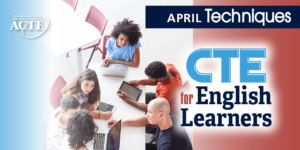Support ELs in CTE programs
For English learners (ELs), their access to career and technical education (CTE) can be limited due to a variety of factors. These include language proficiency restrictions, limited translation services and lack of family outreach. Educators must act with urgency to support representation and engagement. Because when ELs are intentionally included, they may succeed in whichever path they choose.
Review data on EL enrollment to assess representation and identify any barriers that exist. For example, there may be limited outreach conducted in EL families’ home languages about the CTE programs available to students. To address this challenge, set up outreach structures. This outreach can come in many different forms such as field trips, flyers, and application support services. Then the focus can shift to effective instructional practices.
In this article I will outline how scaffolding instruction can support ELs in CTE programs. And how educators can implement five strategies to support ELs in CTE.
- Incorporate explicit vocabulary development into instruction.
- Provide writing support based on strengths and needs.
- Embed peer learning opportunities into instruction.
- Include mini lessons on academic language as appropriate.
- Prepare for certification exams using multiple modalities.
How can scaffolding support ELs in CTE programs?
CTE takes a hands-on approach to learning. Instruction tends to be concrete and provides immediate relevance for all students. CTE programs provide regular opportunities for productive talk in which students work together to solve a problem or create something, making it an ideal place to learn and practice language. CTE can have a positive impact on ELs’ language acquisition. By adding scaffolds to instruction, teachers can help ELs in CTE programs reach their full potential. Scaffolds can help make CTE accessible to ELs at all stages of English language proficiency. And they should be provided based on individual students’ strengths and needs.
Incorporate explicit vocabulary development into instruction.
CTE classrooms are full of technical terms. And we know that vocabulary development is an important part of effective education for ELs in all content areas. Begin by introducing new terminology.
There are many ways to introduce new words, and it is best to use multiple strategies to ensure strong understanding. Use visuals to bring words to life. For example, in a culinary class, the teacher can use items available in the kitchen to model the term mise en place (to have all your ingredients and equipment prepared before you start cooking).
Provide writing support based on strengths and needs.
To support ELs in becoming successful writers, CTE teachers can incorporate explicit writing lessons with appropriate scaffolds that align with individual students’ strengths and needs. For instance, students at the beginning level of English language proficiency may benefit from the use of a model essay or a word bank when writing.
Embed peer learning opportunities into instruction.
Consider how ELs may lack experience in using the English language as a function: to make requests, provide explanations, and discuss problems. Role plays and simulation activities can be valuable tools for language practice. They help students prepare for the situations they will find at work.
Include mini lessons on academic language as appropriate.
Language mini lessons provide an opportunity to teach new language structures as needed throughout a unit. These brief lessons can take place with the whole class or as a small group and connect the language taught to the course content. In other words, the students should use the language in context.
Prepare for certification exams using multiple modalities.
Certification requirements vary by industry and state. No matter, it is important to support ELs in preparing for these exams. Provide students the time to practice and engage with the language and exam structures they will experience. Review exam materials to analyze the language demands of the test. What terms do they need to know? Also, how will the questions be written? Then conduct practice exercises. For instance, multiple-choice exam questions with negative construction (e.g., “All of the following statements are true except one.”) can be challenging to understand without explicit instruction.
Final thoughts
As you consider how best to support ELs in CTE programs, think about the types of supports that individual students need. Secondary CTE programs offer pathways for diverse students across the country. And it is exciting to see educators advocating for ELs’ engagement within these programs.
Meghan Gregoire-Smith, M.A., is a multilingual learner coach for SupportEd.
Learn more about SupportEd
SupportEd is a woman-owned small business with a vision to reimagine the landscape of education for English learners. They provide support to empower students and their educators. Over the past few years, SupportEd has collaborated with educators at Southern Westchester BOCES Center for Career Services, a secondary CTE school in Valhalla, New York, to embed supports for ELs into CTE curricula and instructional practices. This article emerged from lessons we learned through this ongoing collaborative partnership.





